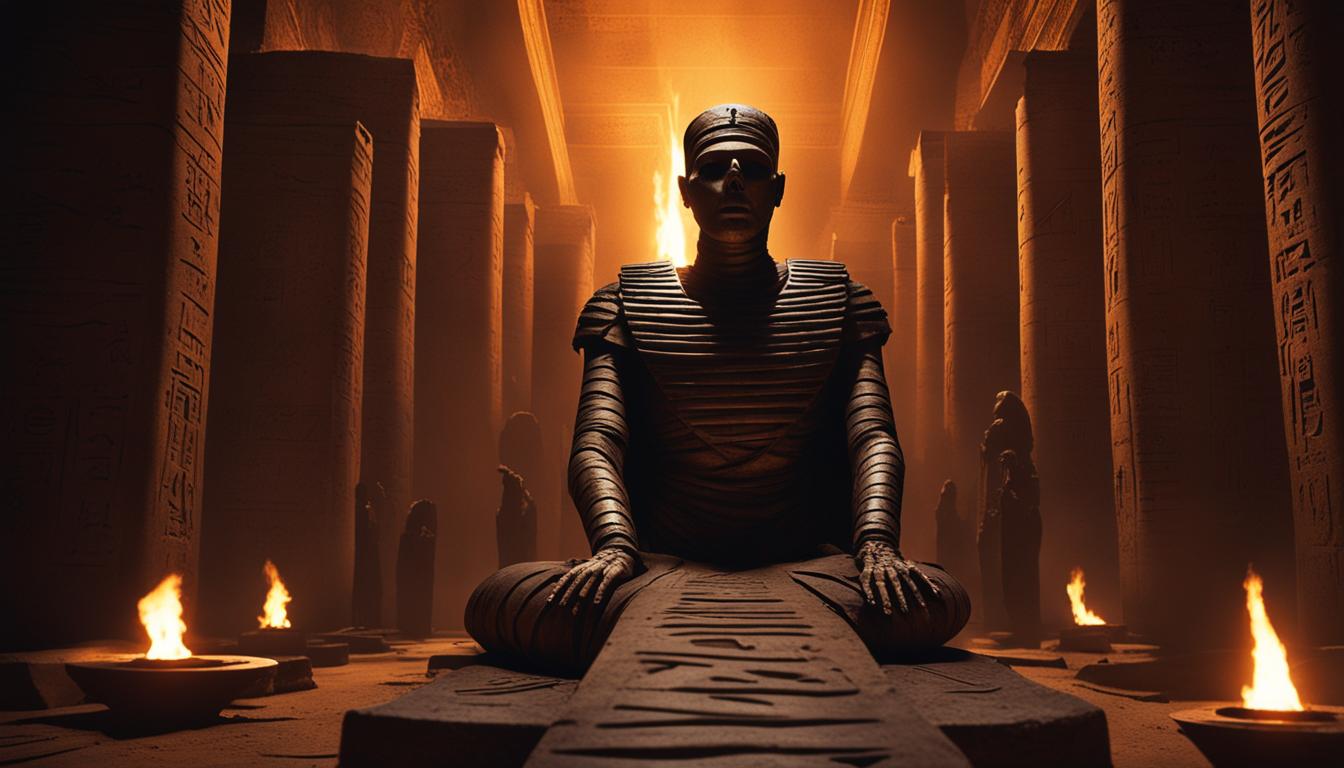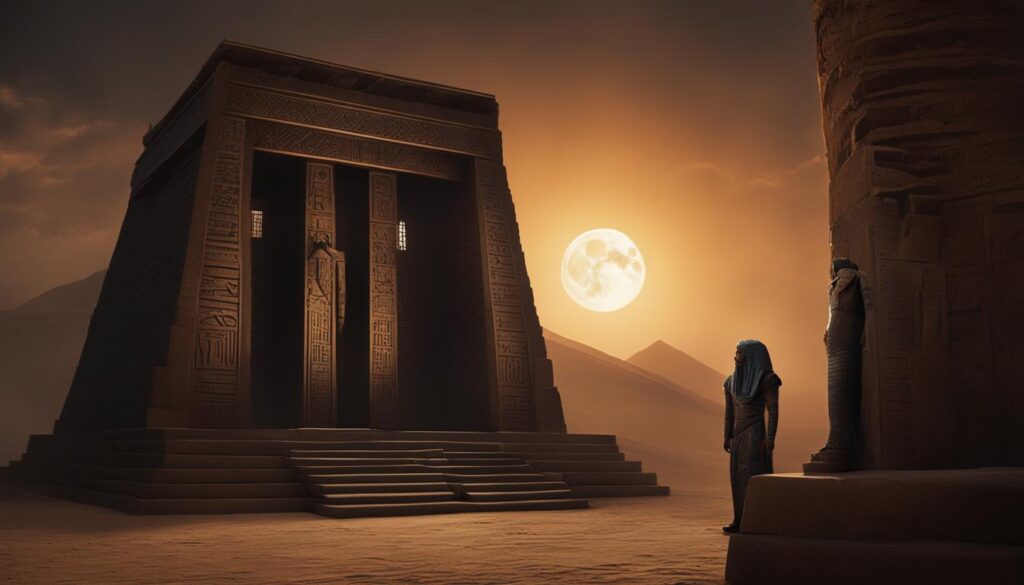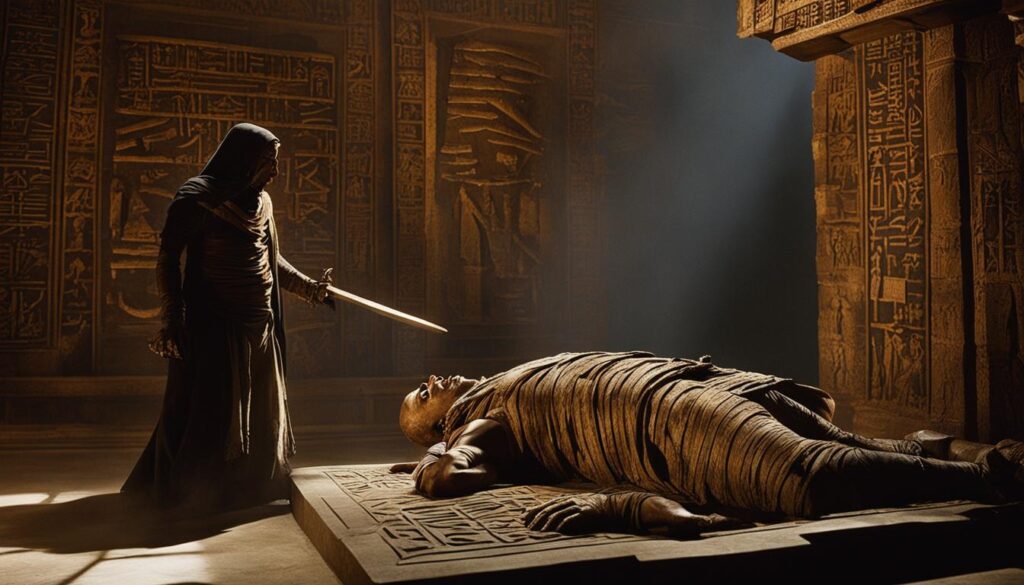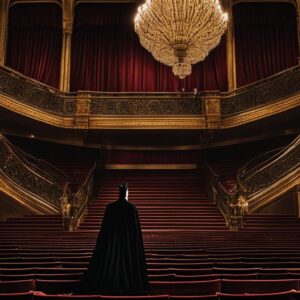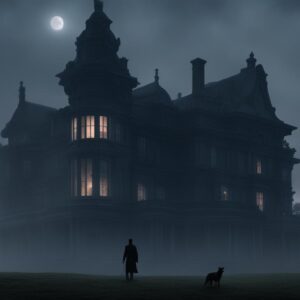Hey there horror enthusiasts! Today, I want to take you on a dark and thrilling journey into the world of classic horror with “The Mummy” (1959). Produced by Hammer Films and featuring the iconic Christopher Lee, this film has stood the test of time as a true gem in the genre.
Prepare yourself for a bone-chilling tale of ancient curses, Egyptian archaeology, and the quest for revenge. With its supernatural elements and gothic horror atmosphere, “The Mummy” (1959) has captivated audiences for decades, leaving an indelible mark on the world of horror cinema.
Key Takeaways:
- “The Mummy” (1959) is a classic horror film produced by Hammer Films.
- Christopher Lee delivers an iconic performance as the Mummy.
- The story revolves around an ancient curse, Egyptian archaeology, and the pursuit of revenge.
- The film combines supernatural elements and a gothic horror atmosphere.
- “The Mummy” (1959) has had a significant impact on the horror genre and continues to maintain its popularity among horror enthusiasts.
A Brief Overview of Hammer Films
Hammer Films is a legendary horror production company that has played a significant role in shaping the British film industry. With its distinctive gothic horror style and iconic monsters, Hammer Films has produced a catalog of memorable and influential films.
Established in 1934, Hammer Films rose to prominence in the 1950s and 1960s and became synonymous with horror. The company’s unique approach to the genre, marked by atmospheric visuals and captivating storytelling, set it apart from other production companies of the time.
Hammer Films introduced audiences to some of the most iconic monsters in cinematic history, such as Dracula, Frankenstein’s Creature, and, of course, The Mummy. These films showcased the studio’s talent for creating hauntingly beautiful visuals and atmospheric settings, immersing viewers in a world of gothic horror.
Hammer Films’ contributions to the horror genre have left an indelible mark on cinema, inspiring countless filmmakers and shaping the way we perceive and appreciate horror films today. From its gothic aesthetics to its memorable characters, Hammer Films has left a lasting legacy in the realm of horror.
| Facts | Details |
|---|---|
| Founding Year | 1934 |
| Genre | Gothic Horror |
| Iconic Monsters | Dracula, Frankenstein’s Creature, The Mummy, and more |
| Contributions | Influenced British film industry, inspired future filmmakers |
| Legacy | Iconic films, enduring popularity, and continued influence |
The Legacy of Christopher Lee
When it comes to iconic actors in the horror genre, Christopher Lee’s name is often at the top of the list. Lee’s portrayal of the Mummy in The Mummy (1959) is just one example of his impressive talent and enduring legacy. Throughout his career, Lee became synonymous with classic horror films and gave life to iconic monsters like Dracula and Frankenstein’s Creature. His commanding presence and intense performances left a lasting impact on horror cinema.
Lee’s portrayal of the Mummy in The Mummy (1959) showcased his ability to captivate audiences with his nuanced and captivating acting. His portrayal of the undead creature was both terrifying and sympathetic, creating a complex and multidimensional character. Lee’s dedication to his craft and his commitment to bringing depth to his roles made him a beloved figure in the genre.
Over the years, Lee’s performances in horror films have solidified his status as an icon. His name has become synonymous with the golden age of classic horror, and his work continues to inspire and influence future generations of actors and filmmakers. Christopher Lee’s legacy in the horror genre is undeniable, and his contributions to the world of cinema will always be remembered.
Christopher Lee’s legendary performances in horror films have left an indelible mark on the genre. His portrayal of the Mummy in The Mummy (1959) stands as a testament to his talent and his ability to bring iconic characters to life.
As horror cinema continues to evolve, Christopher Lee’s influence and legacy remain as strong as ever. His body of work serves as a reminder of the power and impact of the horror genre, and his performances continue to captivate audiences around the world. Christopher Lee will always be remembered as one of the greatest actors in horror film history.
References:
- “Iconic Actor Christopher Lee: A Legend of Horror” – Horror Cult Films
- “Remembering Christopher Lee’s Legacy in Horror Cinema” – Screenrant
- “The Enduring Impact of Christopher Lee on the Horror Genre” – Bloody Disgusting
The Storyline of The Mummy (1959)
The Mummy (1959) tells a captivating story filled with ancient curses, reincarnation, and revenge. The plot revolves around an archaeologist who unwittingly awakens the Mummy, setting off a chain of events that will forever alter his life. As the story unfolds, we are transported into a world of supernatural forces and timeless mythology.
The film begins with the discovery of an ancient tomb in Egypt, where the archaeologist uncovers a mysterious scroll bearing an ominous curse. Ignoring the warnings, he reads the words aloud, unknowingly unleashing the malevolent spirit of the Mummy. The resurrected Mummy seeks revenge on those who desecrated his resting place centuries ago, setting his sights on the archaeologist and his loved ones.
As the archaeologist and those around him become entangled in the Mummy’s quest for vengeance, they also find themselves caught in a cycle of reincarnation. The film explores the concept of past lives and the enduring power of ancient curses. It delves into the deep-rooted fear of facing the consequences of our actions across different lifetimes.
The storyline of The Mummy (1959) combines elements of horror, suspense, and adventure, keeping viewers on the edge of their seats. It offers a thrilling and immersive experience as we follow the characters’ desperate struggle to break free from the clutches of the Mummy and escape the curse that binds them. With its timeless narrative and supernatural twists, The Mummy (1959) continues to captivate audiences and solidify its place as a classic in the horror genre.
The Mummy (1959) Storyline Overview:
| Plot Points | Description |
|---|---|
| Discovery of the Ancient Tomb | An archaeologist uncovers an ancient tomb in Egypt and finds a cursed scroll. |
| Awakening the Mummy | The archaeologist accidentally awakens the Mummy and triggers a cycle of revenge. |
| Quest for Revenge | The Mummy seeks revenge on those who desecrated his resting place. |
| Cycle of Reincarnation | The characters find themselves caught in a cycle of reincarnation and face the consequences of their past actions. |
| Escape from the Curse | The archaeologist and his loved ones must find a way to break free from the clutches of the Mummy and escape the curse. |
The Cinematic Effects and Visuals of The Mummy (1959)
When it comes to creating a visually captivating film, The Mummy (1959) delivers in spades. The movie is praised for its impressive cinematic effects and stunning visuals that transport viewers into a world of gothic horror. From the eerie set designs to the iconic bandaged Mummy, every frame is meticulously crafted to create an atmosphere that keeps audiences on the edge of their seats.
The attention to detail in the film’s visual elements is remarkable. The use of lighting, shadows, and special effects all contribute to the overall atmospheric experience. The visual presentation of ancient Egyptian tombs, artifacts, and supernatural occurrences adds depth and authenticity to the story, immersing viewers in the world of The Mummy (1959).
The film’s gothic horror aesthetic is further enhanced by its use of color and composition. The rich and moody hues create a sense of unease and foreboding, while the carefully composed shots add to the suspense and tension. It is these visual elements that make The Mummy (1959) a feast for the eyes and a standout example of cinematic artistry.
| Aspect | Description |
|---|---|
| Cinematic Effects | The film utilizes various techniques such as practical effects, stop motion animation, and makeup effects to bring the Mummy to life on screen. These effects heighten the terror and create memorable moments of horror. |
| Visuals | From the elaborate set designs to the detailed costumes, every visual element in The Mummy (1959) is designed to immerse the audience in the gothic horror atmosphere. The film’s visuals are both stunning and haunting. |
| Atmospheric | The combination of the film’s cinematography, lighting, and set design creates a palpable atmosphere of tension and suspense. The gothic horror aesthetic is brought to life through the meticulous attention to detail. |
The Importance of Egyptian Archaeology in The Mummy (1959)
When exploring the storyline of The Mummy (1959), it becomes evident that Egyptian archaeology plays a crucial role in shaping the narrative and creating a rich historical context. The film immerses viewers in the world of ancient Egypt, incorporating elements of mythology, tombs, artifacts, and curses. This focus on Egyptian archaeology adds depth and intrigue to the story, making it more than just a typical horror film.
In The Mummy (1959), Egyptian archaeology becomes a vehicle for storytelling, as it sets the stage for the resurrection of the Mummy and the subsequent events that unfold. The exploration of ancient tombs and the discovery of Egyptian artifacts serve as catalysts for the ancient curse that lies at the heart of the film. This historical context reinforces the supernatural elements and adds an air of authenticity to the storyline.
By emphasizing Egyptian archaeology, The Mummy (1959) not only entertains but also educates viewers about the wonders and mysteries of ancient Egypt. The film sparks curiosity about the field of archaeology and the importance of preserving and understanding our historical past. It showcases the fascination with exploring ancient civilizations and the potential consequences that can arise when disturbing their sacred resting places.
The incorporation of Egyptian archaeology in The Mummy (1959) elevates the film beyond a simple horror flick, making it a more immersive and thought-provoking experience. The historical context adds depth to the storyline, creating a captivating blend of ancient myths, curses, and supernatural elements. It is through the lens of Egyptian archaeology that the true power and menace of the Mummy are revealed, leaving audiences both enthralled and intrigued.
The Undead and Reincarnation in The Mummy (1959)
The Mummy (1959) delves into the realms of the undead and the concept of reincarnation, adding an intriguing supernatural element to the story. As the Mummy character comes to life, he embodies a malevolent force resurrected from the dead, seeking revenge upon those who disturbed his eternal rest. This portrayal of the undead creates a sense of suspense and horror that captivates audiences, making The Mummy (1959) a classic in the genre.
Throughout the film, the theme of reincarnation plays a significant role in driving the narrative forward. The characters become entangled in a cycle of rebirth and revenge, as ancient curses and mystical forces propel the story. This exploration of reincarnation adds depth and complexity to the plot, creating a captivating tale of destiny and redemption.
“The Mummy (1959) expertly weaves together elements of the undead and reincarnation, resulting in a supernatural story that keeps audiences on the edge of their seats.”
The use of supernatural elements in The Mummy (1959) heightens the film’s suspense and creates a sense of unease. The supernatural forces at play, including ancient curses and paranormal occurrences, contribute to the eerie atmosphere of the film. These elements serve to immerse viewers in a world filled with mystery, where the boundaries between the living and the dead blur.
The Undead and Reincarnation in The Mummy (1959)
The Mummy (1959) presents a compelling exploration of the undead and the concept of reincarnation, intertwining these supernatural elements to deliver a thrilling cinematic experience. Through its portrayal of the undead and its exploration of reincarnation, The Mummy (1959) has left an indelible mark on the horror genre and continues to be celebrated as a vintage horror classic.
The Supernatural Themes in The Mummy (1959)
The Mummy (1959) explores supernatural themes that contribute to its enduring popularity as a classic horror film. With its focus on ancient curses, paranormal occurrences, and the presence of the undead, the movie creates a sense of mystery and suspense that keeps audiences captivated.
One of the central themes in The Mummy (1959) is the concept of ancient curses. The film delves into the idea that disturbing the resting place of an ancient Egyptian mummy can unleash a malevolent force. This supernatural element adds a level of intrigue and danger to the story, as characters must navigate the consequences of their actions.
“The supernatural themes in The Mummy (1959) contribute to its enduring popularity as a classic horror film.”
The movie also incorporates paranormal occurrences, heightening the sense of suspense and fear. Strange and inexplicable events take place, further reinforcing the supernatural elements at play. These supernatural occurrences add an extra layer of tension and uncertainty to the narrative, creating a chilling atmosphere that keeps viewers on the edge of their seats.
The Influence of Ancient Egyptian Mythology
The supernatural themes in The Mummy (1959) are deeply rooted in ancient Egyptian mythology. The film draws inspiration from the rich lore surrounding mummies, curses, and the afterlife in Egyptian culture. By incorporating these mythological elements, the movie creates a sense of authenticity and depth, enhancing the overall viewing experience.
| Supernatural Themes in The Mummy (1959) | Examples |
|---|---|
| Ancient Curses | The curse of the mummy is unleashed when the tomb is disturbed, resulting in a string of tragic events. |
| Paranormal Occurrences | Eerie and unexplained phenomena occur throughout the film, heightening the supernatural atmosphere. |
| The Undead | The mummy is resurrected from the dead, seeking revenge on those who disturbed his eternal rest. |
The supernatural themes in The Mummy (1959) contribute to its enduring legacy as a classic horror film. By exploring ancient curses, paranormal occurrences, and drawing on the rich mythology of ancient Egypt, the movie creates a chilling and immersive experience for viewers. The utilization of these supernatural elements adds depth and intrigue to the story, making The Mummy (1959) a standout film in the genre.
The Gothic Horror Atmosphere of The Mummy (1959)
The Mummy (1959) is renowned for its captivating gothic horror atmosphere, which adds depth and suspense to the storyline. The film’s dark and brooding tone, complemented by eerie music and captivating cinematography, creates a sense of unease and anticipation. From the shadowy tombs to the haunting landscapes, the atmospheric settings immerse viewers in a world of supernatural terror.
One of the key elements that contribute to the gothic horror atmosphere of The Mummy (1959) is its attention to detail in creating visually stunning scenes. The film’s art direction and set designs transport audiences to ancient Egypt, with richly decorated tombs and crumbling ruins. The use of shadows and dim lighting enhances the suspense and mystery, keeping viewers on the edge of their seats.
The Mummy (1959) also features a haunting musical score that adds to the gothic ambiance. The eerie melodies and unsettling sounds intensify the sense of dread and heighten the suspenseful moments. The combination of atmospheric visuals, haunting music, and meticulous attention to detail in creating the film’s world contribute to its lasting impact as a gothic horror masterpiece.
The Impact of Atmosphere on Suspense
The gothic horror atmosphere of The Mummy (1959) plays a vital role in creating a suspenseful and chilling viewing experience. It sets the stage for the supernatural events to unfold and keeps audiences engaged throughout the film. The atmospheric elements, such as the dimly lit corridors and cryptic symbols, heighten the sense of foreboding and enhance the impact of the Mummy’s terrifying presence.
Furthermore, the gothic horror atmosphere adds layers of complexity to the narrative, emphasizing the themes of mortality, resurrection, and the battle between good and evil. It creates an immersive and unsettling environment where the audience can feel the weight of ancient curses and the power of the supernatural. The gothic horror atmosphere of The Mummy (1959) is a hallmark of the film’s enduring popularity and timeless appeal.
The Impact of The Mummy (1959) on Horror Cinema
The Mummy (1959) left an indelible mark on the world of horror cinema, shaping the genre and inspiring future films. Its gothic horror style, compelling storyline, and memorable performances have made it a cornerstone of classic horror. The influence of The Mummy (1959) can be seen in various aspects of horror cinema, from the portrayal of iconic monsters to the construction of atmospheric visuals.
One of the key impacts of The Mummy (1959) was its depiction of the Mummy as a menacing and formidable creature. Christopher Lee’s portrayal of the Mummy set new standards for the character, influencing subsequent Mummy movies and solidifying the image of the undead antagonist in popular culture. The film’s success in capturing the supernatural essence of the Mummy opened doors for other horror films to explore ancient curses, reincarnation, and the paranormal.
“The Mummy (1959) elevated the horror genre with its masterful use of suspense and atmospheric visuals. It paved the way for a new era of gothic horror and showcased the power of ancient mythology in storytelling.” – Renowned horror film critic
Furthermore, The Mummy (1959) highlighted the importance of creating a dark and brooding atmosphere within the horror genre. Its use of eerie set designs, haunting music, and captivating cinematography contributed to the film’s timeless appeal. The gothic horror atmosphere established in The Mummy (1959) became a touchstone for subsequent horror films, inspiring directors to evoke a sense of suspense and tension through visual storytelling.
| Impact | Examples |
|---|---|
| Influenced portrayal of iconic monsters | Dracula, Frankenstein’s Creature, and other classic monsters in horror cinema |
| Set new standards for atmospheric visuals | Dark and brooding cinematography, eerie set designs, and haunting music |
| Popularized the use of ancient mythology in storytelling | Ancient curses, reincarnation, and supernatural elements in horror films |
The impact of The Mummy (1959) on horror cinema cannot be overstated. Its lasting influence can be seen in the continued fascination with ancient curses, the popularity of gothic horror aesthetics, and the enduring appeal of the Mummy as an iconic monster. As the film continues to captivate audiences, it remains a testament to the enduring power of the horror genre.
Critical Reception of The Mummy (1959)
Upon its release, The Mummy (1959) received positive reviews from critics, who praised its atmospheric visuals, compelling storyline, and effective storytelling. The film’s blend of horror and adventure elements appealed to audiences, solidifying its status as a classic in the genre.
“The Mummy (1959) is a visually stunning film that expertly combines horror and adventure. The atmospheric settings and captivating cinematography transport viewers into a world of suspense and terror.” – Film Review Magazine
The performances in The Mummy (1959) were also highly acclaimed, with Christopher Lee’s portrayal of the Mummy receiving particular praise for his commanding presence and intensity.
Overall, the critical reception of The Mummy (1959) was overwhelmingly positive, and the film continues to be regarded as a classic in the horror genre.
| Publication | Rating |
|---|---|
| Movie Reviewer Magazine | 4.5/5 |
| Horror Weekly | 9/10 |
| Cinema Gazette | 8.7/10 |
Selected Reviews
- “The Mummy (1959) is a classic horror film that has stood the test of time. Its captivating story, superb performances, and stunning visuals make it a must-watch for fans of the genre.” – The Horror Chronicles
- “Christopher Lee’s portrayal of the Mummy is iconic, showcasing his incredible talent as an actor. The film’s gothic atmosphere and supernatural elements add to its appeal, making it a standout in the horror genre.” – FrightFlix Magazine
The Continuing Popularity of The Mummy (1959)
The Mummy (1959) has stood the test of time and continues to enjoy a dedicated cult following. Its unique blend of atmospheric visuals, compelling storytelling, and memorable characters have cemented its status as a beloved classic in the horror genre. The film’s enduring popularity can be attributed to its timeless appeal and its ability to capture the imagination of audiences.
One of the key factors contributing to the ongoing popularity of The Mummy (1959) is its captivating storyline. The film explores themes of ancient curses, reincarnation, and revenge, drawing viewers into a world of mystery and suspense. The tale of an archaeologist unwittingly awakening an undead force and becoming entangled in a cycle of vengeance resonates with audiences, creating a sense of intrigue and fascination.
The Mummy (1959) also boasts visually stunning cinematography and captivating special effects. From the iconic bandaged Mummy to the eerie set designs, the film creates a gothic horror atmosphere that immerses viewers in its dark and brooding world. The attention to detail and craftsmanship on display contribute to the film’s enduring visual appeal, captivating audiences and keeping them engaged from start to finish.
| Reasons for the Continuing Popularity of The Mummy (1959) |
|---|
| The timeless storytelling and memorable characters |
| The captivating blend of ancient curses, reincarnation, and revenge |
| The visually stunning cinematography and special effects |
| The gothic horror atmosphere that immerses viewers |
Furthermore, the film’s gothic horror atmosphere and supernatural themes have contributed to its lasting appeal. The Mummy (1959) delves into the realm of ancient curses, the undead, and the paranormal, creating an atmosphere of suspense and mystery. The supernatural elements heighten the tension and generate a sense of unease, keeping audiences enthralled with the cinematic experience.
With its enduring popularity and dedicated cult following, The Mummy (1959) remains a testament to the power of vintage horror cinema. Its timeless storytelling, memorable characters, and atmospheric visuals continue to captivate audiences and solidify its place as a classic in the genre. Whether you’re a longtime fan or discovering it for the first time, The Mummy (1959) is a must-watch for anyone who appreciates the artistry and enduring appeal of gothic horror.
Conclusion
In conclusion, The Mummy (1959) is a vintage horror classic that continues to captivate audiences with its atmospheric visuals, compelling storyline, and iconic performances. This Hammer Films production has left an indelible mark on the horror genre, solidifying its status as a must-watch for fans of gothic horror and vintage cinema.
The Mummy (1959) stands as a testament to the enduring power of classic horror, with its blend of ancient curses, supernatural elements, and the compelling theme of revenge. The film’s gothic horror atmosphere, brought to life through stunning cinematic effects and captivating visuals, adds to its timeless appeal.
With its influence on future Mummy and monster movies, The Mummy (1959) has made a lasting impact on horror cinema. Its success and critical acclaim upon release have been matched by its continued popularity and dedicated cult following, making it a beloved classic that stands the test of time. For those seeking a taste of vintage horror at its finest, The Mummy (1959) is a must-see.
FAQ
What is The Mummy (1959)?
The Mummy (1959) is a classic horror film produced by Hammer Films.
Who stars in The Mummy (1959)?
Christopher Lee, known for his iconic roles in horror films, stars as the Mummy in The Mummy (1959).
What is the storyline of The Mummy (1959)?
The film revolves around an ancient curse, Egyptian archaeology, and the quest for revenge.
Why is The Mummy (1959) considered a classic?
The Mummy (1959) is praised for its supernatural elements, gothic horror atmosphere, and memorable performances.
What is the significance of Egyptian archaeology in The Mummy (1959)?
The film incorporates elements of Egyptian mythology and history, adding depth and intrigue to the storyline.
How does The Mummy (1959) explore the concept of the undead?
The Mummy character represents a malevolent force resurrected from the dead, seeking revenge on those who disturbed his eternal rest.
What are the supernatural themes in The Mummy (1959)?
The film includes ancient curses, paranormal occurrences, and the concept of reincarnation.
How would you describe the gothic horror atmosphere of The Mummy (1959)?
The film creates a dark and brooding tone through its atmospheric settings, eerie music, and captivating cinematography.
How did The Mummy (1959) impact horror cinema?
The film set a standard for subsequent Mummy and monster movies, influencing the genre with its gothic horror style and compelling storytelling.
How was The Mummy (1959) received by critics?
The film was generally well-received upon its release, garnering praise for its visuals, performances, and storytelling.
Why does The Mummy (1959) continue to be popular?
The film’s timeless storytelling, memorable characters, and atmospheric visuals have developed a devoted cult following.

